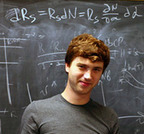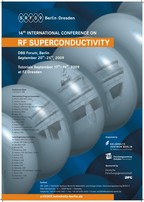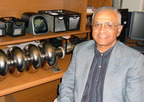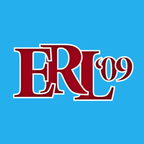SRF News: 2009
Outstanding Young Researcher Award goes to SRF Scientist (09/26)
In recognition of his work with Oscillating Superleak Transducers (OST) a CLASSE junior scientist, Zachary Conway, was awarded one of two outstanding young researcher awards, presented every two years at the international Superconducting Radio-Frequency device workshop. Superconducting niobium accelerator cavities operate at temperatures only a few degrees above absolute zero and, the best, impart more than 30 megavolts of energy to particles which transverse their volume but most fall short of this goal. Now, scientists in Cornell University's Laboratory for Accelerator-based Sciences and Education (CLASSE) are trying to streamline the process of turning underperforming niobium cavities into the state-of-the-art devices they are intended to be. Presently, the majority of superconducting niobium cavities are limited by surface defects. Surface defect location is a cumbersome procedure requiring two or more expensive tests at temperatures just above absolute zero. These expensive cold tests rely on arrays of hundreds to thousands of small temperature sensitive carbon transducers which measure the minuscule heating which is the tell-tale sign of a defect. Cornell CLASSE scientists are in the final development stages of a far more efficient method which utilities a few transducers to detect the thermal wave which propagates away from the defect while the cavity fails. This technique is easily incorporated into current cavity acceptance testing hardware and doesn't require the skilled technicians essential to the carbon based approach. The award was in recognition of the work performed but does not mean the work is finished. Stay tuned for more results. The SRF workshop distributed two awards, and it is noteworthy that the second award also recognized research from Cornell's SRF group.Outstanding Researcher Award goes to SRF group's scientist (09/25)
Alexander Romanenko was awarded one of the two SRF09 prizes at the Berlin International SRF conference on September 25, 2009. Romanenko's PhD dissertation dealt the cause of the high field Q-slope and the baking effect cure for the high field Q-slope. He showed that dislocation clusters present in the first tens of nanometers of the surface lower the critical field for rf flux entry, and increase the resistance of flux motion with rf field due to the flux pinning properties of dislocation clusters found. He also showed that baking a smooth electropolished surface greatly reduces the density of dislocations, so curing the high field Q-slope. The dislocations heal at the baking temperature most likely by the diffusion of vacancies.The SRF workshop distributed two awards, and it is noteworthy that the second award also recognized research from Cornell's SRF group.
14th International Conference on RF Superconductivity (09/20)
The 14th International Conference on RF Superconductivity (SRF2009) was held Sept. 20-25, 2009 at the dbb Forum in Berlin, within walking distance of the famed Checkpoint Charlie. The Conference will be hosted by the Helmholtz-Zentrum Berlin (formerly BESSY) and the Forschungszentrum Dresden-Rossendorf.
Impressive advances in superconducting RF science and technology over the last three decades are responsible for a dramatic increase of SRF installations world-wide. RF superconductivity now is the key technology of many accelerators for particle physics, nuclear physics and, increasingly, light sources. The European Free-Electron Laser and the recently commissioned Spallation Neutron Source are exciting examples of the various applications of SRF.
Continuing the successful tradition of 13 previous workshops, SRF 2009 covered the latest advances in the science, technology, and applications of superconducting RF. The program consisted of invited review talks, poster sessions and "hot-topic" discussion sessions. A special emphasis was placed on providing a forum for student researchers to present their results.
Special tutorials session was held from Sept. 17-19 in Dresden. The tutorials were designed to provide an in-depth overview of SRF related subjects for scientists and engineers new to the field, or those who simply want a refresher.
For further information, please click here.
Hasan Padamsee's retirement party (06/14)
On June 13 we celebrated the retirement of a great researcher, valued colleague, and respected leader in the SRF community, Hasan Padamsee. The dinner and a reception at Cornell University were attended by over 80 friends, family, and local and international colleagues from the SRF community and from funding agencies.Hasan Padamsee received his Ph.D. in Solid State Physics at Northeastern
University in 1973 before joining Cornell where he became a senior research associate and adjunct professor. Hasan had made great strides in advancing the SRF community, high temperature superconductors and particle accelerators. He has written several books including Unifying the Universe: The Physics of Heaven and Earth, RF Superconductivity for Accelerators, and RF Superconductivity: Volume II: Science, Technology.
Hasan will remain very active in his retirement. He has been appointed a regular adviser to the SRF group in general, and to his successor as head of the group, Georg Hoffstaetter, in particular. And he has already agreed to consulting activities for Fermi National Accelerator Laboratory and to the Helmholz Zentrum Berlin. He will also remain on several international advisory and organizing committees.
Cornell hosts third international ERL workshop (06/13)
The third international ERL workshop was held at Cornell from June 8-12. It was the 45th Beam Dynamics workshop through the ICFA, promoting Energy Recovery Linacs for their full range of applications, including light sources for the spectrum from infrared radiation to hard x-rays, electron coolers for high energy ion beams, and electron beams for nuclear physics colliders. Because ERLs are nearly exclusively based on Superconducting Linear Accelerators, Cornell's SRF group played a dominant role in this workshop, with the head of the group, Georg Hoffstaetter, chairing the organizing committee and of the program committee. Remarkable advancements with technologies required for Energy Recovery Linacs, particularly SRF technology, has made them a key option for future x-ray sources.The conference aimed to address fundamental challenges related to the generation of high brightness and simultaneously high average current electron beams with Energy Recovery Linacs. Specific topic include: high brightness electron guns, RF control and stability under very loaded Q, orbit stability, beam-quality preservation during acceleration and energy recovery. The program included both presentations by speakers from many different accelerator groups, tours of the Cornell accelerator, and a joint banquet with the CHESS users workshop.
For more information about the event, including a list of covered topics, please click here.







